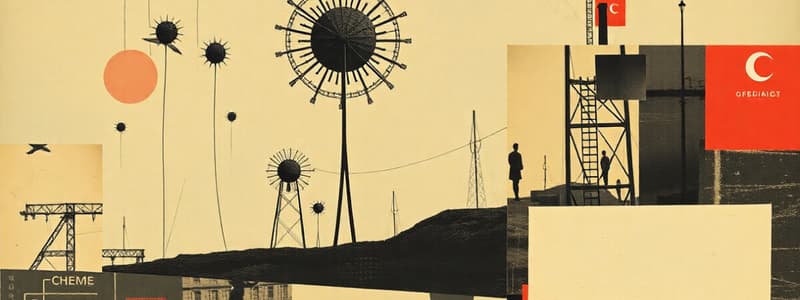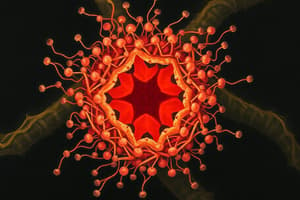Podcast
Questions and Answers
What process results in the diversity of immunoglobulins in B cells prior to encountering an antigen?
What process results in the diversity of immunoglobulins in B cells prior to encountering an antigen?
- RNA splicing
- Somatic hypermutation
- Gene duplication
- VDJ recombination (correct)
Which segments of DNA contribute to the assembly of a variable region of an immunoglobulin?
Which segments of DNA contribute to the assembly of a variable region of an immunoglobulin?
- V, D, and J segments (correct)
- V and C segments only
- J and C segments only
- C and J segments only
What is the main difference between secreted and membrane-bound antibodies?
What is the main difference between secreted and membrane-bound antibodies?
- They are encoded by different genes.
- They differ in their C-terminal regions. (correct)
- They are produced by different B-cell types.
- They have different isotopes.
Which of the following accurately describes immunoglobulin isotypes?
Which of the following accurately describes immunoglobulin isotypes?
What is the role of the leader sequence in the immunoglobulin heavy-chain locus?
What is the role of the leader sequence in the immunoglobulin heavy-chain locus?
How many functional Jκ gene segments are there in the κ light-chain locus?
How many functional Jκ gene segments are there in the κ light-chain locus?
What is the significance of hybridomas in the context of monoclonal antibodies?
What is the significance of hybridomas in the context of monoclonal antibodies?
In the human immunoglobulin heavy-chain locus, how many functional VH gene segments are present?
In the human immunoglobulin heavy-chain locus, how many functional VH gene segments are present?
What is the primary purpose of V(D)J recombination in B cells?
What is the primary purpose of V(D)J recombination in B cells?
What is the main role of alternative mRNA splicing in B cells?
What is the main role of alternative mRNA splicing in B cells?
Which component is part of the B cell receptor (BCR) complex?
Which component is part of the B cell receptor (BCR) complex?
Which immunoglobulin isotypes are co-expressed in activated B cells?
Which immunoglobulin isotypes are co-expressed in activated B cells?
What distinguishes secreted antibodies from membrane-bound antibodies?
What distinguishes secreted antibodies from membrane-bound antibodies?
What is the significance of junctional diversity in B cell development?
What is the significance of junctional diversity in B cell development?
During the creation of monoclonal antibodies, what is the initial step involving mouse lymphocytes?
During the creation of monoclonal antibodies, what is the initial step involving mouse lymphocytes?
Which factor is crucial for the survival of hybridoma cells during monoclonal antibody production?
Which factor is crucial for the survival of hybridoma cells during monoclonal antibody production?
What forms the functional B-cell receptor complex in B cells?
What forms the functional B-cell receptor complex in B cells?
During alternative RNA processing in B cells, what determines the form of immunoglobulin produced?
During alternative RNA processing in B cells, what determines the form of immunoglobulin produced?
What is the role of the carboxy terminus in the heavy-chain RNA of immunoglobulins?
What is the role of the carboxy terminus in the heavy-chain RNA of immunoglobulins?
Which of these components is NOT associated with the B-cell receptor complex?
Which of these components is NOT associated with the B-cell receptor complex?
What happens to the heavy-chain RNA when the transcript is processed for a secreted form of immunoglobulin?
What happens to the heavy-chain RNA when the transcript is processed for a secreted form of immunoglobulin?
What type of immunoglobulin is primarily found as a B-cell receptor on the B-cell surface?
What type of immunoglobulin is primarily found as a B-cell receptor on the B-cell surface?
Which process uniquely enhances immunoglobulin diversity in B cells?
Which process uniquely enhances immunoglobulin diversity in B cells?
How do the heavy-chain C genes contribute to the differentiation of antibody forms?
How do the heavy-chain C genes contribute to the differentiation of antibody forms?
What determines the choice between the secreted and membrane-bound forms of immunoglobulin during RNA processing?
What determines the choice between the secreted and membrane-bound forms of immunoglobulin during RNA processing?
What is the significance of the long cytoplasmic tails of Igα and Igβ proteins?
What is the significance of the long cytoplasmic tails of Igα and Igβ proteins?
What is the correct order of immunoglobulin molecules as they appear during B cell development?
What is the correct order of immunoglobulin molecules as they appear during B cell development?
Which immunoglobulin isotypes are co-expressed on the surface of a mature B cell?
Which immunoglobulin isotypes are co-expressed on the surface of a mature B cell?
During isotype switching, which immunoglobulin molecule is typically produced first?
During isotype switching, which immunoglobulin molecule is typically produced first?
What are the two types of IgA identified during B cell development?
What are the two types of IgA identified during B cell development?
What process allows a B cell to produce multiple types of immunoglobulins?
What process allows a B cell to produce multiple types of immunoglobulins?
Which immunoglobulin is primarily expressed during the early stages of B cell development?
Which immunoglobulin is primarily expressed during the early stages of B cell development?
Which immunoglobulin is associated with allergic responses?
Which immunoglobulin is associated with allergic responses?
How many subclasses of IgG are there?
How many subclasses of IgG are there?
Which immunoglobulin isotype is produced first during the splicing process?
Which immunoglobulin isotype is produced first during the splicing process?
What immunoglobulin isotype results when an IgM heavy chain is swapped for an alpha heavy chain?
What immunoglobulin isotype results when an IgM heavy chain is swapped for an alpha heavy chain?
In which scenario would both IgM and IgD be expressed on the surface of a B cell?
In which scenario would both IgM and IgD be expressed on the surface of a B cell?
Which immunoglobulin isotype can switch from IgG to IgA?
Which immunoglobulin isotype can switch from IgG to IgA?
Which of the following best describes the relationship between IgM and IgD expression?
Which of the following best describes the relationship between IgM and IgD expression?
What does isotype switching allow B cells to do?
What does isotype switching allow B cells to do?
Which immunoglobulin isotype would not typically be found on the same B cell as IgM?
Which immunoglobulin isotype would not typically be found on the same B cell as IgM?
What is the result of V(D)J recombination in B cells?
What is the result of V(D)J recombination in B cells?
What is the first step in the somatic recombination process for the heavy chain of immunoglobulins?
What is the first step in the somatic recombination process for the heavy chain of immunoglobulins?
In the formation of a functional light chain, what is combined with the variable region after VJ joining?
In the formation of a functional light chain, what is combined with the variable region after VJ joining?
Which immunoglobulin molecule is produced when the constant mu region is selected during the heavy chain recombination process?
Which immunoglobulin molecule is produced when the constant mu region is selected during the heavy chain recombination process?
During alternative mRNA splicing in B cells, what ultimately determines the specific form of immunoglobulin produced?
During alternative mRNA splicing in B cells, what ultimately determines the specific form of immunoglobulin produced?
What is the main function of the junctional diversity that occurs during B cell development?
What is the main function of the junctional diversity that occurs during B cell development?
What key molecular event occurs at the membrane coding exons during immunoglobulin production?
What key molecular event occurs at the membrane coding exons during immunoglobulin production?
Which of the following is a characteristic of the isotypes IgM and IgD co-expression in B cells?
Which of the following is a characteristic of the isotypes IgM and IgD co-expression in B cells?
Isotype switching in B cells largely depends on which of the following processes?
Isotype switching in B cells largely depends on which of the following processes?
Flashcards are hidden until you start studying
Study Notes
Immunoglobulin Diversity in B Cells Before Antigen Encounter
- Immunoglobulin is first made in a membrane-bound form that's present on the B-cell surface.
- Igα and Igβ form a disulfide-linked complex that interacts with the immunoglobulin molecule.
- Igα and Igβ have long cytoplasmic tails that interact with intracellular signaling proteins.
- Igα and Igβ have binding sites for immunoglobulin C region on their extracellular portions.
- The complex of immunoglobulin with Igα and Igβ serves as the functional B-cell receptor.
- All isotypes can serve as B-cell receptors.
- Igα and Igβ are also called CD79a and CD79b.
Diversification of Antibodies After Antigen Encounter
- Secreted antibodies are produced by an alternative pattern of heavy-chain RNA processing.
- Each heavy-chain C gene has two exons (membrane-coding, MC & secretion-coding, SC) encoding the carboxy terminus.
- Membrane-coding (MC) encodes the transmembrane region & cytoplasmic tail of the surface form.
- Secretion-coding (SC) sequence encodes the carboxy terminus of the secreted form.
- Alternative RNA processing determines whether a heavy-chain RNA will result in a secreted or transmembrane immunoglobulin.
- Each heavy-chain C gene has two potential polyadenylation sites (pAμs & pAμm).
- To generate the transmembrane form of the heavy chain, the transcript is cleaved and polyadenylated at the second polyadenylation site (pAμm).
- Splicing between a site located between the fourth Cμ exon & SC sequence, & a second site at the 5ʹ end of MC exons, removes the SC sequence and joins MC exons to the fourth Cμ exon.
The Structural Basis of Antibody Diversity
- The DNA sequence encoding a V region is assembled from two or three gene segments.
- The λ light-chain locus has ~30 functional Vλ gene segments, 4 pairs of functional Jλ, and a Cλ gene segment.
- The κ light-chain locus has ~35 functional Vκ gene segments & 5 Jκ gene segments with ONE Cκ gene segment.
- The heavy-chain locus has ~40 functional VH gene segments, a cluster of ~23 D segments, & 6 JH gene segments.
- A monoclonal antibody is produced by a clone of antibody-producing cells.
- To make a monoclonal antibody, lymphocytes from a mouse are immunized with an antigen of choice and fused with myeloma cells.
- Fused cells are grown with a drug that kills myeloma cells but permits growth of hybrid cells.
- Cultures of hybrid cells (hybridomas) are tested to determine whether they make the desired antibody.
- Cultures containing a hybridoma making the desired antibody are cloned to produce a homogeneous culture of cells making the monoclonal antibody.
- Myelomas are tumors of plasma cells; those used to make hybridomas were selected not to express antibody heavy and light chains.
Overview
- Epitope specificity of immunoglobulins is determined before antigen encounter.
- The number of possible epitope-binding specificities is greater than the number of genes within the genome.
- Each heavy-chain locus has multiple V, D, and J gene segments that are rearranged to produce a diverse array of antibodies.
- This process is known as V(D)J recombination.
- The rearrangement of these gene segments is mediated by specific enzymes, including RAG1 and RAG2.
- Junctional diversity is generated during gene rearrangement, increasing the diversity of antibodies.
- The process of V(D)J recombination contributes significantly to the diversity of the immune system.
Immunoglobulin Heavy Chains
- Immunoglobulin molecules are arranged in a specific order with IgM appearing first, followed by IgG, IgA and then IgE.
- The order reflects the location of the heavy chain genes on the genome.
- IgM and IgD genes are closely adjacent on the genome leading to their co-expression on the surface of B cells.
- B cells express both IgM and IgD during development, but only express IgD upon maturation.
- There are four subtypes of IgG (IgG1, IgG2, IgG3, and IgG4) and two subtypes of IgA (IgA1 and IgA2).
- Each immunoglobulin domain is coded by a separate exon.
Immunoglobulin Heavy Chain Assembly
- During the assembly of heavy chains, the D and J segments recombine first, followed by the V segment.
- The recombined VDJ region then joins with a constant region gene, determining the immunoglobulin class.
- The constant region gene determines the class of the immunoglobulin molecule, such as IgM, IgG, IgA, or IgE.
- Two membrane coding exons (MC) specify a hydrophobic sequence that anchors the immunoglobulin to the cell membrane.
- This hydrophobic sequence will later be cleaved off during the maturation process.
Immunoglobulin Light Chains
- The light chains are assembled by recombining a variable segment (V) with a joining segment (J).
- The VDJ region then joins with a constant region gene to produce a complete light chain.
Studying That Suits You
Use AI to generate personalized quizzes and flashcards to suit your learning preferences.




